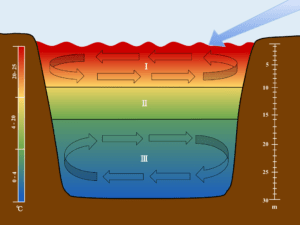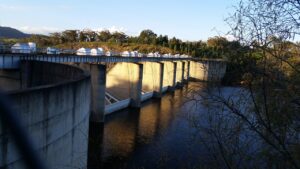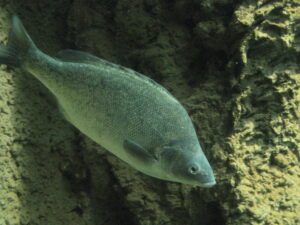Paper: Michie, Laura E., et al. “Effects of suboptimal temperatures on larval and juvenile development and otolith morphology in three freshwater fishes: implications for cold water pollution in rivers.” Environmental Biology of Fishes (2020): 1-14. https://doi.org/10.1007/s10641-020-01041-z

An illustration of how differences in temperature occur in lakes. The top layer (I) of the lake gets heated by the sun and generally doesn’t mix with the bottom layer (III), which stays relatively cool as a result. Image by Mbrookings19 via Wikimedia Commons.
A story of cold water pollution
Anthropogenic, or human caused, climate change is increasing water temperatures throughout the world. These warmer waters can impact the migration of marine animals, and affect their growth, reproduction, and survival. However, human impacts can also make water much colder than usual, and this can have equally devastating consequences for organisms. At Australia’s Burrendong Dam, for example, very cold water from Burrendong Lake’s bottom is frequently released into the surrounding river system (causing what is called cold pollution, or cold water pollution) to prevent dam flooding. This input can decrease water temperature up to 16℃ (up to 60℉!), which likely has a significant effect on the fishes that inhabit these rivers. In particular, newborn or juvenile fishes that have experienced cold pollution can have their growth stunted. These fishes become significantly smaller than adult fishes who have not experienced cold water pollution, making it harder to obtain food, reproduce, and avoid predators. This trend begs the question – are fish species that are currently threatened in the wild (meaning likely to soon become endangered) affected by cold water pollution more than non-threatened species? If so, could cold pollution be a reason these species are threatened, and should conservation efforts focus on combating it? Researchers based at the University of Technology Sydney sought to study the rivers surrounding the Burrendong Dam to answer this question.
Collecting and cooling fish

The Burrendong Dam in Australia. When cold water from deep in Burrendong Lake, present behind the dam, flows into the subsequent river systems, cold water pollution can occur. Image from Needpix.com.
To compare the effects of cold water pollution on threatened and non-threatened fish species near Burrendong Dam, two threatened fish species, silver perch and trout cod, were compared with golden perch, a non-threatened species. All fishes were 31 days old at the start of the experiment and were acclimated to one of four temperature conditions – 13℃, 16℃, 20℃, and 24℃. These fishes typically grow in waters around 20℃, but could also experience all the experimental temperatures in their native rivers. Fishes were exposed to the temperature treatments for 30 days, and then measured and weighed. Special attention was also paid to the shape of the fish.
Does cold water pollution affect fish growth?
Overall, all of the fishes were much smaller at 13℃ and 16℃ compared to 20℃ and 24℃. Silver perch and trout cod (the threatened fishes) raised in the warmest waters were nearly double the length of the fishes in the coolest waters. For silver and golden perch, fishes at 13°C barely grew at all over the 30 day period, and the length of trout cod only increased by about 25%. The same pattern held for weight measurements, with silver perch and trout cod being almost 10x heavier after 30 days at 24℃ than at 13℃. There were also clear trends in shape, as silver perch and trout cod were shaped very differently in each of the temperature categories, while the golden perch were a bit more similar throughout the temperature range. These shape differences were primarily in areas of head and body width, with fish raised in cooler temperatures having smaller mouths and thinner bodies overall.

An adult silver perch, one of the threatened species analyzed in this study. Adults can be 30-40cm long, while the juvenile silver perch in this study ranged from less than 10mm when raised at 13°C to 50mm at 24°C. While the fish studied were not done growing, this stark difference between treatments highlights how different these fish would look at adult ages. Image by Mitch Ames via Wikimedia Commons.
How do these differences impact threatened fish species?
It is clear from these results that the threatened species (silver perch and trout cod) are more negatively affected by cold water pollution than golden perch, a non-threatened species. While this does not prove that cold water pollution is responsible for the decline of silver perch and trout cod, it is likely a part of the problem. By stunting fish growth, cold water pollution creates fishes that are smaller and thinner than normal for an extended period of their lives. Since smaller fishes cannot swim as quickly as larger fishes, they are easier targets for predators. By leaving fishes with smaller mouths that aren’t able to consume their normal variety of prey, cold water may also cause fishes to starve and/or be malnourished. Additionally, a smaller fish may not be a viable candidate for a mate, harming reproduction.
Overall, it is clear that cold water pollution can negatively impact fishes in many ways, and humans should seek solutions to combat this issue. By finding a way to manage the temperature of water that is released from lakes and dam systems, or by avoiding this process altogether, we can save current and future generations of fishes from stunted growth, and perhaps even extinction.

I am a PhD candidate at Wake Forest University, and I received a B.S. in Biology from Cornell University. My research focuses on the terrestrial locomotion of fishes. I am particularly interested in how different fishes move differently on land, and how one fish may move differently in different environments. While I tend to study small amphibious fishes, I’ve had a lifelong fascination with all ocean animals, and sharks in particular. When not doing science, I enjoy running, attempting to bake and cook, and reading.